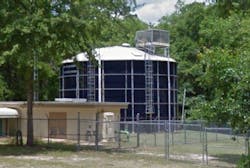Deep in the Apalachicola National Forest in the Florida panhandle where U.S. 319 makes a crank-handle turn stands the community of Sopchoppy. It’s an Indian name that means “dark water” or “twisted river.” In fact, the Sopchoppy River is one of the most pristine rivers in the whole state and it attracts a crowd for boating, kayaking and fishing.
Just 40 miles southwest of Tallahassee but a world away from the hustle and bustle, Sopchoppy is home to about 400 people who prefer the peaceful life and look forward to the annual Worm Grunting Festival, where worms are coaxed to the surface of the earth and harvested for bait.
Years ago, the Carrabelle, Tallahassee and Georgia railroad rumbled through here, but it shut down and was later replaced by a scenic trail. All that remains today is the old depot, built in 1891 and lovingly restored in recent years. In fact, Sopchoppy is one of few communities that boasts a school gymnasium on the National Register of Historic Places.
A good chunk of Wakulla County’s utility needs are served by the City of Sopchoppy. Approximately 10,000 individuals get their water from the district via 4,000 connections. The district pumps about 21 million gal of water each month; it is sourced from seven wells fed by the Floridan aquifer, which is replenished by rainwater filtering through hundreds of feet of sand and rock.
The Solution
Not quite as old as the Floridan aquifer but just as critical to the area’s needs is the city’s Aquastore glass-fused-to-steel storage tank. Built in 1985, the tank has withstood the test of time and the elements, and it looks and performs like new. Sopchoppy has four other tanks—all steel—but they do not provide the same level of durability, appearance and affordability.
“The Aquastore tank has more than performed as advertised in every aspect,” said Public Works Director Leonard Tartt. “By comparison, the steel tanks fade over time and need to be repainted, and they need more repair than the Aquastore.”
The Florida Department of Environmental Protection requires that tanks be inspected and pressure-washed every five years, and Tartt says the only repairs made to the Aquastore are re-caulking some seams. During the same period, the steel tanks have had to be sandblasted and repainted several times to ward off corrosion.
“At $80 dollars a gallon, the cost of paint really adds up,” he said.
CST—a provider of modular, factory-coated bolted storage tanks for dry bulk and liquid applications for many markets—builds Aquastore tanks. The Aquastore is made of glass and steel fused together at 1,500°F. With its inert, inorganic coating, the Aquastore withstands heat, cold and moisture, and it maintains its luster compared to steel tanks, which require painting. An Aquastore tank is easy to clean and maintain, and is not susceptible to corrosion, cracking and mildew..
“The Sopchoppy tank is among the first Aquastore water tanks our company built in Florida, and it continues to make us proud,” said John Viale, territory manager at Florida Aquastore, CST Storage’s exclusive turnkey provider of Aquastore tanks throughout Florida, southern counties in Georgia, the Caribbean and Central and South America. “It looks and performs like new, and I know Leonard gets the most out of its 239,000-gal capacity.”
In fact, during the warm months the district uses the tank almost to capacity day in and day out.
“I’ve never had problems with it, even though in the peak of summer, the turnover will be 225,000 to 230,000 [gpd],” said Tartt. “Then we’ll throttle it back a bit during the winter.”
Erecting an Aquastore tank is simple. The geodesic dome is hoisted into place while panels are assembled underneath. Jacks are used to lift the tank higher to make room for additional panels. No one has to leave the ground, and the tank can be installed in the tightest of spaces.
The Aquastore is compatible with other specialized systems. For example, the district installed an aerator on the top of the tank to help remove hydrogen sulfide. Other elements, such as iron and calcium, can be dealt with because they are easy to wash off the tank surface.
Tartt has lived in Wakulla County all his life. He served on Sopchoppy’s city council and was the mayor before taking over the public works role. He has seen quite a bit in his time and has a good perspective on what is built to last.
“Everybody looks at the bottom line nowadays, but I also look at quality and historical performance, what’s worked and what hasn’t,” he said. “You can get a fire hydrant that will pass codes but [is] less costly, but will it last 50 years? It’s basically the same thing. You have a little added cost with ground storage because you need service pumps. But when you consider the tradeoff, the Aquastore comes out ahead every time.”
The railroad may not have survived in these parts, but odds are good for the Aquastore tank, which is still performing at a superior level at age 31.
